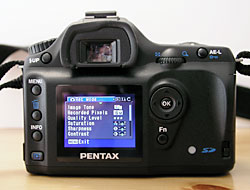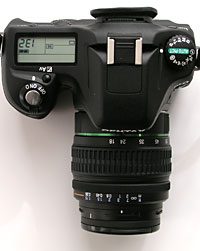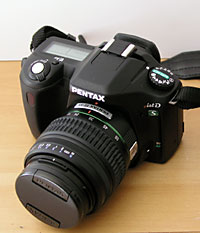|
|||||||||
Advertisement |
Pentax *ist DS 6.1 Megapixel Digital SLR Camera
Review posted Feb. 2005 by Lisa Gade, Editor in Chief and avid photographer
Fast forward to early 2005 and serious amateur photographers have a heavenly array of $1,000 SLRs to choose from. Canon has left their somewhat bulky Rebel unchanged, but the price has dropped. The new Digital Rebel XT, announced for the PMA show in Feb. 2005 will soon replace it. Nikon has their D70, released in Jan. 2004 and Olympus has the E-Volt with its unusual viewfinder design (not a pentaprism) and a sensor aspect ratio usually found in non-SLR digicams. Both Canon and Nikon have SLRs that are priced somewhere between these and full professional models if you hanker for a little more but can't justify $5,000 on a digicam. But this is an article about Pentax' latest offering, the oddly named *ist DS which came out just a few months ago. This is the first digital SLR that's perfect for serious photographers and those who merely want the better image quality an SLR affords. Or perhaps you feel that $1,000 is better spent on an SLR you can grow with than a high end all-in-one digicam at the same price. While offering all the manual controls of an SLR, the *ist DS' Auto Pict mode will have beginners shooting excellent photos with a press of the shutter button. If you're an experienced SLR photographer, the Pentax offers the manual controls and program modes you crave. Pentax is a long established name in SLR film photography, though their name doesn't hold as much clout in the 35mm SLR camp as Nikon and Canon. Pentax is nonetheless a fine SLR manufacturer, whose reputation is tops when it comes to medium format cameras and great glass (lenses). In fact, some folks choose Pentax SLRs based on their amazing lens which are more reasonably priced than Canon and Nikon branded lenses. It has been said that the only thing Pentax lacks is enough marketing. The *ist DS follows on the heels of the well received *ist D which cost several hundred dollars more, offered a very similar feature set but had a CF slot rather than the DS' SD slot. The SD slot may be camera's Achilles heel since serious photographers have a penchant for CF cards which are available in high speeds, in high capacities and lower price tags. But the SD card has gotten darned fast (we have reviews of several 60x SD cards) and 1 gig high speed cards can be had for $70 these days. |
|
*ist DS Features
The *ist DS is a 6.1MP camera capable of shooting images at a maximum resolution of 3008 x 2008 in JPEG and RAW formats. It has an 11 point autofocus system and you can set the focus area to auto, center or set the focus to one of the 11 AF areas (indicated in the viewfinder). You can lock focus by pressing half way down on the shutter button, and autofocus times were very good in our tests. As you'd expect, it has three metering modes (16 area multi--segment, center and spot) and depth of field preview. The 4,000th top shutter speed will suit sports photographers, and it has mirror lockup for slow timed shots. The Pentax has a metal body (rare in a d-SLR in this price range) and a stainless steel lens mount which accepts pretty much every Pentax lens ever made, including manual focus lenses. The camera's KAF mount accepts K, KA, KAF and KAF2 lenses. You can even use screw-mount medium format lenses for the Pentax 645 with the *ist DS and an adapter. If you're a Pentax film SLR owner with a collection of good lenses, the *ist DS is a no-brainer. The camera's quality is superb and the amount of money you'll save by retaining your expensive glass is irresistible.
The *ist DS is the smallest and lightest digital SLR on the market, and is significantly easier on the neck than the Canon Digital Rebel or even the Nikon D70. If you've ever spent 6 hours with an SLR and decent lens around your neck while hoping to record relaxing vacation moments or shoot long sports events, you'll appreciate the Pentax' light load and small size. It measures 4.9" x 3.6" x 2.6" and weighs 18 ounces. Though compact, it's still comfortable for large-handed individuals. Pentax managed to fit a 2" LCD into this small wonder, and the camera runs on rechargeable NiMH batteries or two CR-3V disposables or Lithium Ion AA disposables. You can use alkaline AA disposables but don't expect to get many shots out of them. The Pentax shoots approximately 750 images on a set of high capacity NiMH rechargeables or a set of CR-3V disposables. Those who travel will appreciate not having to carry spare proprietary batteries or bring a charger on the road. The *ist DS has a USB 2.0 interface and comes with a video cable (standard RCA jack termination) for playback on TVs or other video playback equipment.
What's in the Box
The *ist DS is sold two ways: body only (somewhat harder to find) and with a kit lens. The kit lens is a decent starter 18 to 55mm zoom (smc DA 18-55mm f3.5-5.6). Other than the lens, the two packages are identical. They include the camera, two CR-3V Lithium Ion disposable batteries, camera strap, rubber eyepiece surround, hotshoe cover, viewfinder cap, USB cable, video cable, detailed manuals and software CD for Windows and Macintosh.
Controls and Menus
As is the case with most digital SLR cameras, several controls are located on the body with the remainder being software based and thus located in the LCD's menus. The controls are sensibly laid out with the top dial for choosing scene or program mode on the left, power switch on the right just in front of the status LCD which shows remaining shots, battery status, metering mode, program mode, aperture and shutter speed, among other things. The AE-lock button is on the top right rear corner and the button to raise the flash is on the upper left corner. A knurled control wheel on the back allows you to change the current shutter or aperture setting when in Tv and Av modes. The manual/auto focus slider is located beside the lens and the lens lock switch is just where you'd find it on a film SLR camera. Film photographers will feel at home with these standard controls and their locations, while digicam users will easily recognize the various menu control buttons flanking the 2" color LCD: menu, info, Fn and OK.
 |
 |
Pressing the Fn button brings up four of the most commonly used settings: white balance, ISO, flash control and drive mode. The info button shows current settings: AF, program or scene setting, metering mode, ISO, quality setting, white balance, zoom setting in mm and the date and time. The menu button takes you to four pages of settings. Rec. Mode where you can set image tone, quality (one to three stars), resolution, saturation, sharpness, contrast, instant review, auto bracketing, AE metering, flash exposure compensation and the arcanely abbreviated switch distance measuring point (Swtch dst msr pt). Fortunately, only a few menu items carry such terse phrases. The next menu is dedicated to playback settings, followed by the Set-up menu and lastly the Custom Setting menu where you can set noise reduction, exposure setting steps, AE-lock with AF lock, meter operating time, manual white balance measuring (center or entire screen), color space and much more. You'll navigate all on-screen menus using the 4-way directional pad which surrounds the OK button. All in all, the menus are efficient and relatively intuitive.
Next-> Go to Review Page 2 (image quality, sample photos, software, conclusion)
|
Specs:
|


